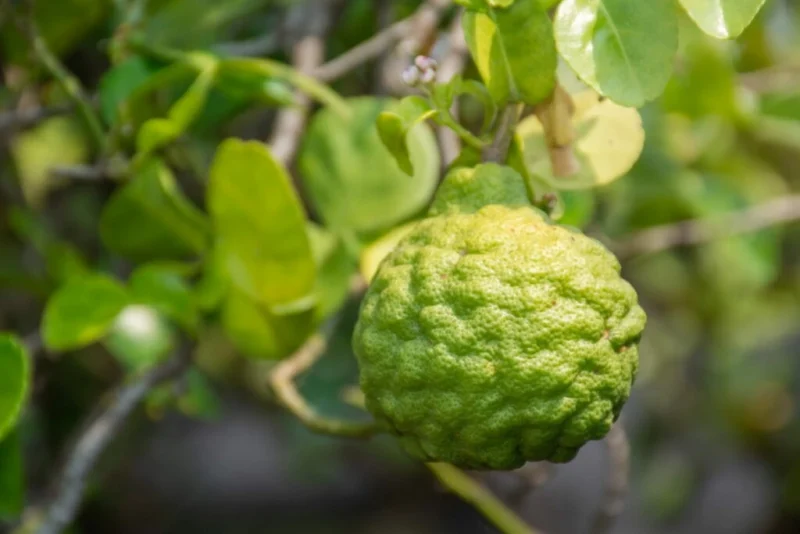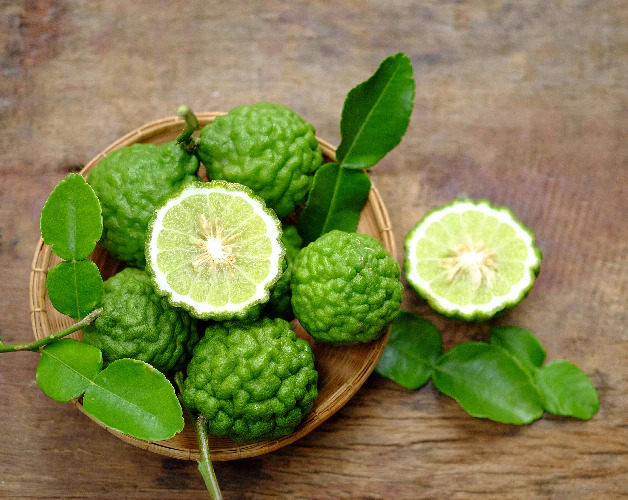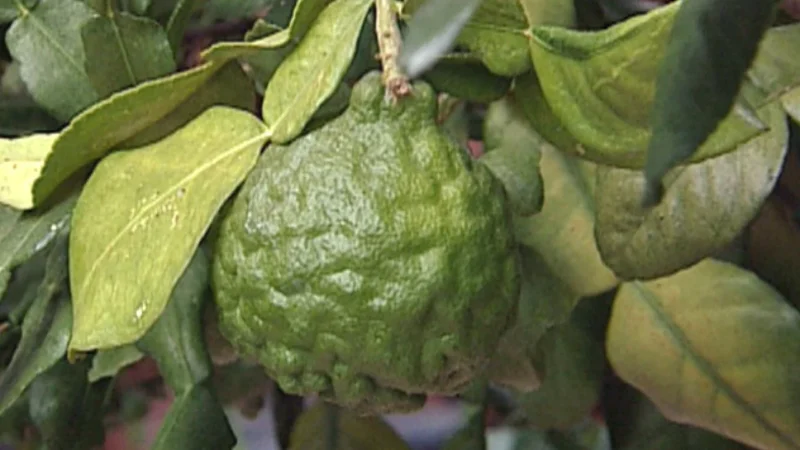Have you ever wanted a steady supply of fresh kaffir lime leaves for your Thai and Southeast Asian dishes? Or maybe you’re looking for a low-maintenance indoor plant that smells amazing and adds a tropical vibe to your home? Growing kaffir lime indoors is the perfect solution!
Unlike other citrus trees, kaffir lime (Citrus hystrix) thrives in containers, making it ideal for small spaces and colder climates. However, it does require specific care to flourish indoors. Let’s dive into the benefits, challenges, and best practices for growing a healthy kaffir lime tree inside your home.

Benefits of Indoor Kaffir Lime Plants
Bringing a kaffir lime tree into your home is more than just a gardening project—it’s a way to add beauty, fragrance, and fresh flavors to your daily life!
1. A Natural Air Freshener & Decorative Houseplant
The glossy green leaves and refreshing citrus scent make kaffir lime a stunning indoor plant. Unlike artificial air fresheners, this tree naturally fills your home with a light, zesty aroma that’s both calming and invigorating.
2. Fresh Leaves for Cooking Anytime
Love Thai food? Having a steady supply of fresh kaffir lime leaves takes homemade curries, Tom Yum soup, and stir-fries to the next level. The leaves add a bold, citrusy flavor that dried versions simply can’t match.
3. Perfect for Small Spaces & Cold Climates
No garden? No problem! Kaffir lime trees thrive in containers, making them ideal for apartments, balconies, and kitchens. Plus, since they’re grown indoors, you can enjoy fresh leaves year-round, even if you live in a cooler climate.
Challenges of Growing Kaffir Lime Indoors
-
Requires specific light and humidity conditions: Kaffir lime needs plenty of sunlight and a warm, humid environment, which can be tricky indoors.
-
Potential pest issues: Like other citrus plants, it can attract pests such as spider mites, scale, and aphids.
How to Grow Kaffir Lime Indoors
Choosing the Right Kaffir Lime Plant
When growing kaffir lime indoors, choosing the right plant is the first step to success. Instead of starting from seeds, which can take years to mature, it’s best to buy a healthy, established plant from a trusted nursery.
For the best results, opt for dwarf or grafted varieties, as they are more suitable for container gardening and adapt well to indoor conditions. These compact plants not only thrive in pots but also produce flavorful leaves much sooner, making them a great choice for home cooks and gardening enthusiasts alike.
Ideal Growing Conditions
-
Light requirements: Place your kaffir lime plant in bright, indirect sunlight for at least 6-8 hours per day. A south-facing window is ideal.
-
Temperature and humidity: Keep temperatures between 65-85°F (18-29°C) and humidity levels above 50%. If your home is dry, consider using a humidifier or misting the leaves regularly.
-
Soil type: Use well-draining, slightly acidic soil (pH 5.5-6.5). A citrus potting mix with added perlite works well.
Planting and Potting
-
Choosing the right pot
Selecting the right pot is crucial for healthy root development and overall kaffir lime care. Since these plants prefer well-draining conditions, choose a sturdy container with drainage holes to prevent water from pooling at the bottom, which can lead to root rot. A pot that is at least 12-14 inches in diameter gives the roots enough space to spread while keeping the plant compact for indoor growth. Terracotta pots are a great option because they allow excess moisture to evaporate, helping to maintain the right soil moisture balance.
-
Step-by-step planting instructions
Once you have the right pot, follow these simple steps to plant your kaffir lime tree:
-
Prepare the soil – Use a well-draining citrus potting mix, which provides the right balance of aeration and nutrients. You can also mix in a bit of sand or perlite to improve drainage.
-
Position the plant – Place the kaffir lime tree in the center of the pot, making sure the roots are spread out gently. Avoid planting too deep—keep the base of the trunk at soil level.
-
Fill with soil – Add more soil around the roots, gently pressing it down as you go. Leave about an inch of space from the rim of the pot to allow for easy watering.
-
Water thoroughly – Give the plant a deep watering to help settle the soil and eliminate air pockets. Going forward, only water when the top inch of soil feels dry.
-
Find the perfect spot – Place your kaffir lime tree in a bright, sunny location, such as near a south-facing window. If natural light is limited, supplement with a grow light to keep your plant thriving.
If you’re looking for a complete guide on how to grow kaffir lime trees, check out this detailed resource for step-by-step instructions.
Watering and Fertilizing
-
How often to water: Water when the top inch of soil feels dry. Avoid overwatering, as kaffir lime roots are prone to rot.
-
Best fertilizers for kaffir lime plants: Use a citrus-specific fertilizer every 4-6 weeks during the growing season (spring and summer).
Caring for Your Indoor Kaffir Lime Plant

Pruning and Shaping Your Indoor Kaffir Lime Tree
Proper pruning is key to keeping your growing kaffir lime indoors healthy, compact, and productive. Regularly trimming leggy branches helps maintain an attractive shape and encourages denser growth. Here’s how to keep your tree looking its best:
-
Trim leggy branches – This helps maintain a bushy, compact form, especially important for container-grown plants.
-
Remove dead or yellowing leaves – This not only improves the plant’s appearance but also prevents disease from spreading.
-
Pinch off new growth – Doing this at the tips encourages more branching, leading to fuller foliage.
Pruning is best done in early spring or after the main growth flush. Always use clean, sharp scissors or pruning shears to make precise cuts.
Would you like some tips on how often to prune for best results?
Pest and Disease Management for Kaffir Lime Care
Even when kept indoors, kaffir lime trees can attract pests like spider mites, aphids, and scale insects. These tiny invaders can weaken your plant if not managed properly.
Natural Remedies and Prevention:
-
Spray with neem oil or insecticidal soap – This helps eliminate pests without harming the plant.
-
Wipe leaves with a damp cloth – Cleaning the leaves removes dust and discourages insects from settling.
-
Maintain humidity – Dry air encourages spider mites, so misting the plant or using a humidifier can help.
A healthy plant is more resistant to pests, so regular care goes a long way.
Would you like advice on identifying early signs of pest problems?
Encouraging Flowering and Fruit Production
If you want your kaffir lime tree to bloom and eventually produce fruit, consistency is key. Since indoor environments can lack some of the natural triggers for flowering, here’s how to encourage blooms:
-
Provide plenty of light and warmth – A sunny window or grow light ensures the plant gets at least 6-8 hours of light daily.
-
Use a phosphorus-rich fertilizer – Fertilizers with higher phosphorus (like a bloom booster) help promote flower formation.
-
Hand-pollinate if necessary – If your tree blooms but doesn’t fruit, use a small brush to transfer pollen between flowers.
Harvesting and Using Kaffir Lime Leaves

When and How to Harvest Kaffir Lime Leaves
One of the best things about growing kaffir lime indoors is that you can harvest its fragrant leaves year-round. However, the plant experiences the most vigorous growth in spring and summer, making these seasons ideal for frequent harvesting.
Proper Harvesting Techniques:
-
Use sharp scissors or pruning shears to snip mature leaves at the base of the stem.
-
Avoid removing too many leaves at once—harvest no more than one-third of the foliage to keep the plant healthy.
-
Regular, light harvesting encourages new growth and bushier foliage over time.
Would you like tips on how to dry and store kaffir lime leaves for long-term use?
Culinary Uses of Kaffir Lime Leaves
Kaffir lime leaves are a staple in Southeast Asian cuisine, known for their citrusy, aromatic flavor that enhances both savory and sweet dishes. Some of the most popular ways to use them include:
-
Thai Green Curry – The leaves add a signature fragrance to the curry’s creamy coconut base.
-
Tom Yum Soup – Essential for this classic Thai hot and sour soup.
-
Kaffir Lime-Infused Cocktails – Adds a unique citrus note to drinks like mojitos and gin-based cocktails.
Storing Fresh and Dried Leaves:
-
Fresh Leaves: Keep them in a sealed bag in the refrigerator for up to two weeks to retain their flavor.
-
Dried Leaves: Store them in an airtight container in a cool, dark place, and they will stay aromatic for several months.
Troubleshooting Common Issues

Even with the best kaffir lime care, issues can arise. The key to a healthy plant is recognizing problems early and making quick adjustments.
Yellowing Leaves
If your kaffir lime tree’s leaves start turning yellow, it’s often a sign of:
-
Overwatering – Too much moisture can suffocate roots, leading to yellow leaves.
-
Nutrient Deficiency – A lack of nitrogen or other essential nutrients can cause leaf discoloration.
-
Low Humidity – Dry indoor air can stress the plant, especially in winter.
How to Fix It:
-
Let the top inch of soil dry out before watering again.
-
Use a balanced citrus fertilizer to ensure proper nutrition.
-
Increase humidity by misting the leaves or placing a water tray near the plant.
Would you like recommendations on the best fertilizers to keep your plant thriving?
Lack of Growth or Fruit Production
If your kaffir lime tree isn’t growing well or producing fruit, the most common culprits are:
-
Insufficient light – Citrus trees need at least 6-8 hours of bright sunlight daily.
-
Improper feeding – Lack of essential nutrients can slow growth and prevent flowering.
-
Pruning issues – Over-pruning or not pruning at all can impact fruiting.
How to Fix It:
-
Move your plant to a brighter spot or supplement with a grow light.
-
Feed with a citrus-specific fertilizer high in nitrogen and phosphorus.
-
Prune carefully to remove weak growth while maintaining a strong, bushy shape.
FAQs About Growing Kaffir Lime Indoors
-
Can kaffir lime trees grow indoors year-round? Yes, kaffir lime trees can grow indoors year-round if they receive adequate light, warmth, and humidity. Keeping them near a sunny window and supplementing with grow lights in winter will help maintain healthy growth.
-
How long does it take for a kaffir lime tree to bear fruit indoors? It usually takes around 2-3 years for an indoor kaffir lime tree to bear fruit. However, proper care, including the right amount of light, nutrients, and occasional hand-pollination, can speed up the process.
-
What is the best way to increase humidity for indoor kaffir lime plants? The best way to maintain humidity is by using a humidifier, placing a tray of water near the plant, or misting the leaves daily. Keeping the plant away from heating vents and drafts can also help retain moisture.
-
Are kaffir lime leaves edible? Yes, kaffir lime leaves are widely used in Southeast Asian cuisine for their intense citrus aroma and flavor. They are commonly added to curries, soups, and stir-fries, either whole or finely chopped.
Final Thoughts
Growing kaffir lime indoors may require some attention, but the reward of fresh, fragrant leaves and a beautiful citrus plant makes it worth it. With the right care, your kaffir lime tree will thrive inside your home, providing you with fresh ingredients and a touch of tropical greenery all year long.
Ready to start growing? Grab a healthy kaffir lime plant and transform your indoor space with this fragrant citrus gem!
